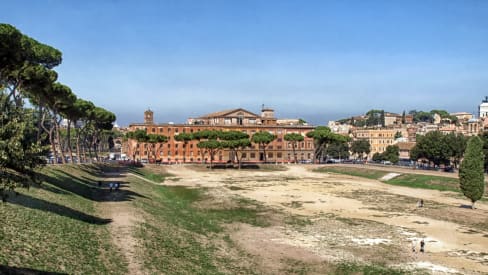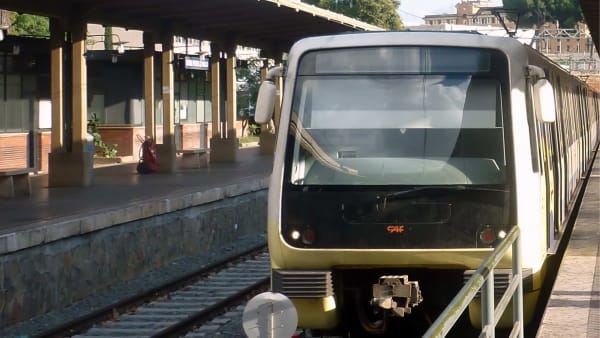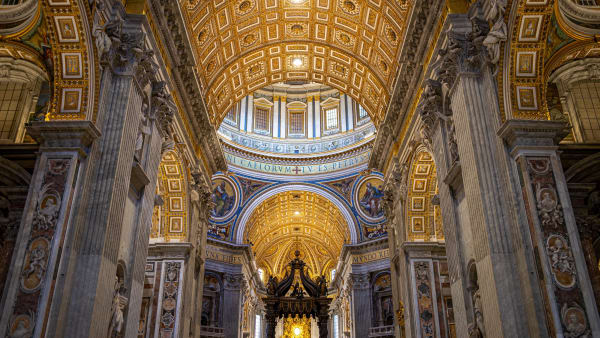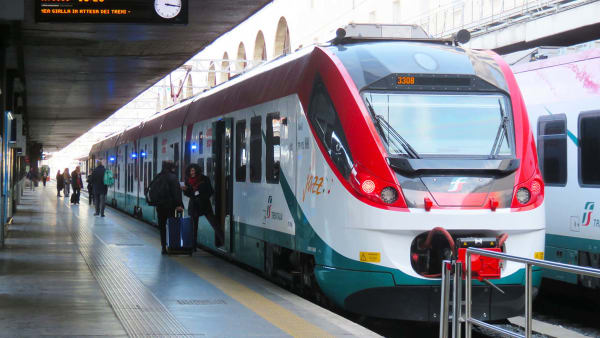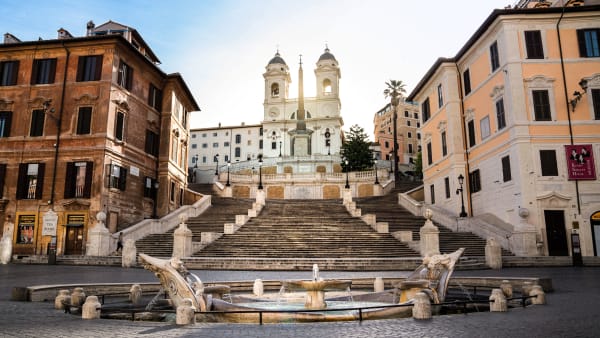Brief history
Brief history
Along with amphitheaters, Roman circuses were the main centers of entertainment. However, the Circus Maximus was the biggest public space of all in Rome and was a huge achievement for architecture at the time.
Monarchical period (753 to 509 BC)
The place where the Circus Maximus was built, was initially a large, flat area formerly known as Vallis Murcia. On the one hand, the valley used to drain rainwater towards the Tiber River. On the other hand, from the time of the city’s foundation, it was the perfect place for people to come together, conduct market activities, and socialize with other communities.
In the 6th century BC, the fifth king of Rome, Tarquinius Priscus, ordered the construction of a horse race track. This was the first part of the Circus Maximus; there were no grandstands or carceres (explained below) at that time. The stream that flowed through the valley, was channeled and bridged.
Republican period (509 - 27 BC)
In 329 BC the carceres were built. The literal translation of the word carceres is dungeon or prison, but here it refers to the horses’ stables and the starting points for the race. Athletes entered the stadium through the Pompae gate and the Romans sat on the hills surrounding the circus to watch the spectacles. The grandstands were built later.
Starting from 46 BC, Gaius Julius Caesar had the first masonry seats constructed in the circus and gave the building its final shape.
He also ordered the digging of a canal that served to drain water into the river that ran along the outer side of the circus. Furthermore, it had the function of protecting the spectators from the wild animals involved in the games.
A fire in 31 BC (the first of three) destroyed a big part of the first wooden structure. Emperor Augustus had it rebuilt, added a pulvinar (imperial box), and placed new decorations on the spina (separation wall).
The cavea, the space intended for spectators, was divided into three levels. These were horizontally separated by corridors and vertically divided by stairs. The lower part that was nearest to the track was occupied by the senators. The part above it was reserved for the horsemen and the rest for the remaining audience.
Imperial period (27 BC - 476 AD)
A second fire in 64 AD lasted six days and destroyed a large part of the city and the Circus Maximus, which was then rebuilt by Nero.
Also the emperor Titus made changes to the Circus Maximus. In 81 AD, two years after his death, Domitian ordered to build the Arch of Titus in his honor. Back then it was added to the stadium but today it’s not there anymore to be admired. By the way, this arch shouldn’t be confused with the arch of the Roman Forum.
Trajan also influenced the refinement and enlargement of the stadium. After a major fire in 103 AD he decided to rebuild the circus but this time he replaced wood with stone. Most of what remains of the circus today dates back from this time. Other emperors who made changes to the circus or ordered restorations include Domitian, Antoninus Pius, Caracalla, and Constantine I (also known as Constantine the Great).
Medieval era (476 - 1492)
At this point, the dimensions of the circus were remarkable, as mentioned in the introduction. The external facade had three tiers: the lower one was twice as high as the other two and had arches. The cavea rested on masonry structures, which housed the passages and stairs to reach the different seating sections, the internal service areas, and the exterior elongated tabernae (shops).
After the Circus Maximus fell into disrepair during the Middle Ages, the area was used for vineyards and vegetable gardens. At that time, the district was owned by the noble Frangipane family who had large numbers of simple huts built there.
From 1145, the family also owned the Torre della Moletta on the south side of the circus. It was called like this because it used to stand next to a mill. However, people also used to call it the Torris in Capite Circi, Turris de Arco, or Torre dei Frangipane.
Today the tower looks a bit abandoned, but in the Middle Ages, it was part of the Frangipani’s defense line near the Palatine, of which there are no remains.
The last game in the Circus Maximus was organized by Totila in 549 AD, almost a thousand years after the stadium was first used. At this time there was no longer an institution that organized races, games or other entertainment in the stadium. Besides, the Christian culture considered the bloody exhibitions unethical.
Renaissance (1492 - 1789)
During the Renaissance, the Circus Maximus became the headquarters of stores, workshops, handicraft businesses, and homes. In 1587 (at the request of Sixtus V), the two large Egyptian obelisks that originally stood on the spina were brought to light at Piazza del Popolo and Piazza San Giovanni in Laterano.
There are also traces of the Jewish community of Rome at that time. In 1645, a Hebrew cemetery was established on the slopes of the Aventine hill, some cypress trees of which still indicate the ancient location.
In this historical period, circus shows took on a distinct character compared to the one developed at the time of Ancient Rome, also due to the Catholic persecutions mentioned before. These were milder performances, with jugglers, acrobats, puppets, and trained animals; which took place in different buildings. These shows were very far from the bloody and vicious contests of the Circus Maximus.
According to written sources from that time, a company of stonemasons was allowed to demolish buildings and appropriate materials in broad daylight, under the supervision of the authorities. For the creation of St. Peter’s Basilica, for example, materials (including travertine) from the Colosseum, the Fornix of Lentulus, the Circus Maximus, and a hundred other monuments were used.
Contemporary age (1789 - present)
Nowadays, the ancient layout of the circus is recognizable due to the persistence of the structure of some artisan stores (a blacksmith, a curtain workshop, and a tavern) at the end of Via dei Cerchi, under the Palatine Hill. The liberation work took place between 1911 and the following years.
In the 1930s, extensive excavations brought to light a large part of the hemicycle and the remains of the Arch of Titus. Later, the area was ceded to the Fascist Party, which, because of its great symbolic value, used it for events such as the National Textile Exhibition of 1937-1940.
In the post-war period, it returned to being green space, in which the ancient structures were substantially abandoned.
Subsequent interventions have given the monument a new identity, redefining the area of the hemicycle by restoring the structures, curbing the site, and constructing new visitor paths with associated lighting systems.
Recently completed archaeological research in 2016, has enriched the framework of knowledge about the monument. Today, numerous events are held every year in the ancient Roman circus.
Among the many artists that have performed here are the Rolling Stones (71.527 people audience), Bruce Springsteen (100.000 people audience), and Genesis (500.000 people audience). The circus has also hosted celebrations, such as Italy’s victory at the 2006 World Cup and the Golden Jubilee of Pope Francis.


